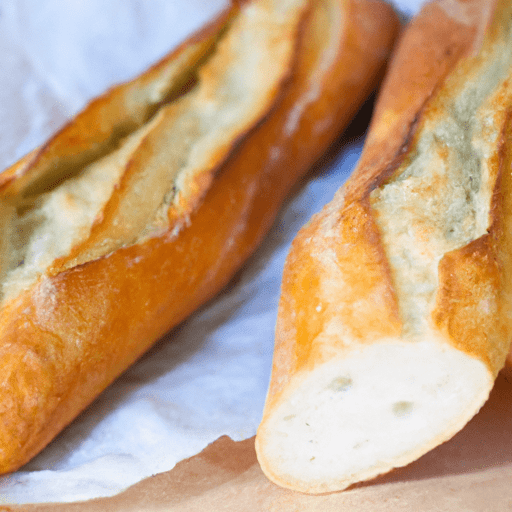The Irresistible Thin Baguette: A Culinary Delight
When it comes to the world of bread, few things can rival the iconic thin baguette. Its unmistakable shape, irresistible crunch, and tender interior make it a favorite among bread enthusiasts and culinary connoisseurs alike. In this blog post, we will dive deep into the world of the thin baguette, exploring its unique taste, common uses in cooking, nutritional value, and uncovering interesting historical facts.
A Taste Sensation
The thin baguette boasts a flavor profile that is both delicate and robust. With a crisp, golden crust and a light, airy interior, its texture alone is enough to make your taste buds dance with joy. But it doesn’t stop there; the flavor is equally impressive. The baguette’s subtle tang and slightly sweet undertones make it a versatile companion for a wide range of culinary creations.
Culinary Inspiration
The thin baguette has become a staple in kitchens around the world due to its versatility and ability to enhance a multitude of dishes. One of its most popular uses is for sandwiches, whether it be the classic French jambon-beurre or a creative interpretation bursting with vibrant flavors. The baguette acts as the perfect vessel, its delicate structure complementing the fillings, allowing them to shine.
But the baguette’s culinary prowess doesn’t end there. It serves as an ideal accompaniment to soups, stews, and salads, adding a satisfying crunch and an elevated texture to every bite. Sliced and toasted, it becomes a delightful base for bruschetta or crostini, creating the perfect canvas for an array of delectable toppings.
Nutritional Value
While the thin baguette is undoubtedly a treat for the senses, it also offers some nutritional benefits. With its focus on simplicity and traditional ingredients, it is low in fat and cholesterol-free. Additionally, it contains a decent amount of dietary fiber, providing a feeling of fullness and contributing to a healthy digestive system. However, it’s important to remember that moderation is key, as the baguette does contain carbohydrates which can affect blood sugar levels.
History and Fun Facts
The story of the thin baguette is steeped in rich history and interesting anecdotes. Originating in France during the early 19th century, the baguette quickly gained popularity and became a symbol of the country’s culinary heritage. Legend has it that the elongated shape resembling a staff or “baguette” gave rise to its distinctive name.
Despite its French origins, the thin baguette has transcended geographical boundaries and has become a beloved bread variety worldwide. In fact, in 2019, the French baguette was granted UNESCO protected status, recognizing its cultural significance and the artistry involved in its production.
Did you know that there is a longstanding tradition in France known as the “Grand Prix de la Baguette de Tradition Française de la Ville de Paris”? The competition aims to find the best baguette in Paris, with the winner earning the honor of supplying the President of France with fresh baguettes for an entire year.
Conclusion
The thin baguette continues to captivate food enthusiasts with its irresistible taste, versatility, and rich history. Whether you enjoy it as the star of a sandwich or as a humble accompaniment to a meal, its iconic shape and satisfying crunch make it a joy to behold and savor. So, the next time you encounter a freshly baked baguette, take a moment to appreciate its artisanal craftsmanship and indulge in the delight of this culinary treasure.
Origin of Thin Baguette:
The thin baguette is a type of bread with its origins in France. It was first created around the 18th century, and its name “baguette” actually means “stick” or “wand” in French, referring to its long and slender shape.
Common Uses:
The thin baguette is commonly used in a variety of ways. It is often served as a side with meals or used as a base for sandwiches and crostini. The crusty exterior and soft interior make it a popular choice for making French toast or bread crumbs for coating meats and vegetables.
Nutritional Benefits:
The nutritional profile of a thin baguette can vary depending on the specific recipe and ingredients used. However, as a general rule, baguettes are low in fat and cholesterol-free. They are a source of carbohydrates and provide a moderate amount of dietary fiber.
Unique Properties:
The thin baguette is known for its distinctive characteristics. Its elongated shape with a crisp and crusty exterior is achieved through a technique called the “poolish” method, which involves the use of a pre-ferment or starter dough. This produces a light and airy interior with irregular holes. A traditional thin baguette should have a golden crust that crackles when squeezed.
Historical Significance:
The introduction of the thin baguette played a significant role in the history of French bread. Prior to its creation, bread in France was typically made in large, round loaves. The baguette’s development allowed for a quicker baking time and easier handling. Over time, it became an iconic symbol of French cuisine and culture, both domestically and internationally.




Use the share button below if you liked it.
It makes me smile, when I see it.